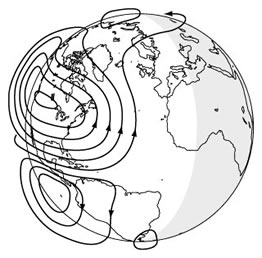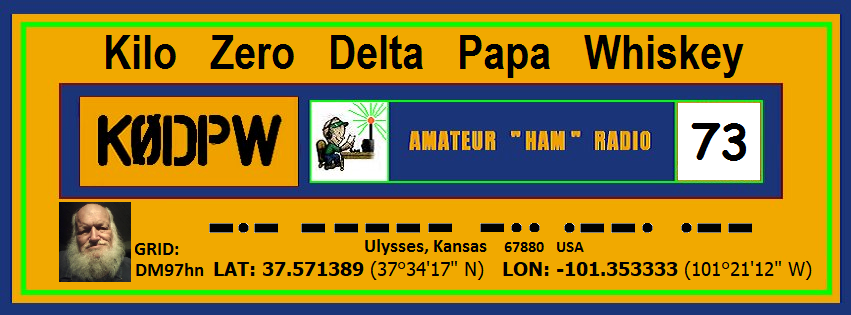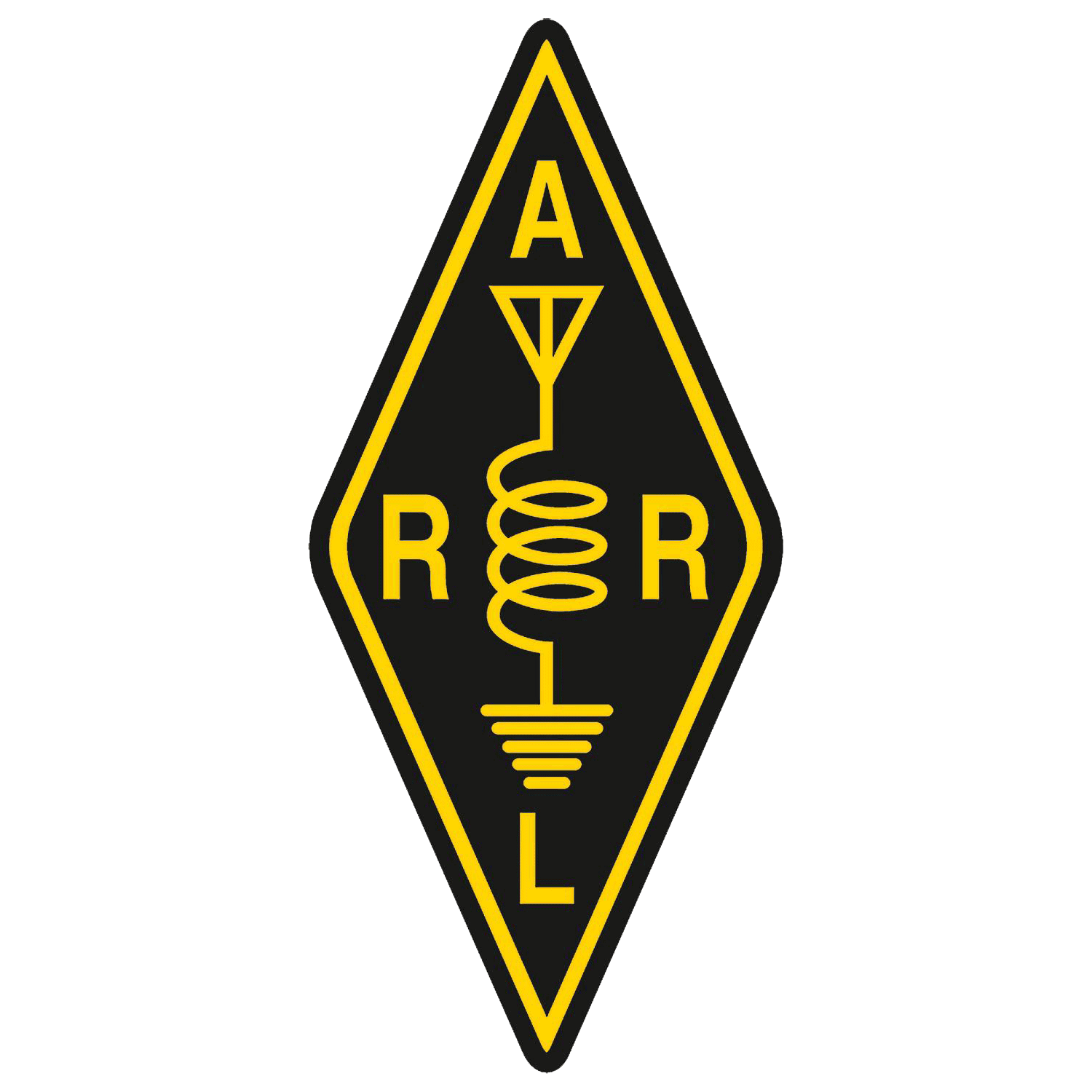|
|
IONOSPHERE
The ionosphere is a region of Earth's upper atmosphere, from about 60 km (37 mi) to 1,000 km (620 mi) altitude, that includes the
thermosphere and parts of the
mesosphere and
exosphere. It is ionized by solar radiation, plays an important part in atmospheric electricity and forms the inner edge of the magnetosphere. It has practical importance because, among other functions, it influences
radio propagation to distant places on the Earth.
DX communication, popular among amateur radio enthusiasts, is a term given to communication over great distances. Thanks to the property of ionized atmospheric gases to refract high frequency (HF, or shortwave) radio waves, the ionosphere can be utilized to "bounce" a transmitted signal down to ground. Transcontinental HF-connections rely on up to 5 bounces, or hops.
Geophysically, the state of the ionospheric plasma may be described by four parameters: electron density, electron and ion temperature and, since several species of ions are present, ionic composition. Radio propagation depends uniquely on electron density.
|

|
The ionosphere is a shell of electrons and electrically charged atoms and molecules that surrounds the Earth, stretching from a height of about 50 km (31 mi) to more than 1,000 km (620 mi). It exists primarily due to ultraviolet radiation from the
Sun.
The lowest part of the Earth's atmosphere, the
troposphere extends from the surface to about 10 km (6.2 mi). Above that is the
stratosphere, followed by the
mesosphere. In the stratosphere incoming solar radiation creates the
ozone layer. At heights of above 80 km (50 mi), in the
thermosphere, the atmosphere is so thin that free electrons can exist for short periods of time before they are captured by a nearby positive ion. The number (density) of these free electrons is sufficient to affect radio propagation. This portion of the atmosphere is partially ionized and contains a
plasma which is referred to as the ionosphere. In a plasma, the negative free electrons and the positive ions are attracted to each other by the electrostatic force, but they are too energetic to stay fixed together in an electrically neutral molecule.
|
Ionosphere Layers
|

|
At night the F layer is the only layer of significant ionization present, while the ionization in the E and D layers is extremely low. During the day, the D and E layers become much more heavily ionized, as does the F layer, which develops an additional, weaker region of ionisation known as the F1 layer. The F2 layer persists by day and night and is the main region responsible for the refraction and reflection of radio waves.
|
D layer
The D layer is the innermost layer, 60 km (37 mi) to 90 km (56 mi) above the surface of the Earth. Ionization here is due to Lyman series-alpha hydrogen radiation at a wavelength of 121.6 nanometre (nm) ionizing nitric oxide (NO). In addition, high solar activity can generate hard X-rays (wavelength < 1 nm) that ionize N2 and O2. Recombination rates are high in the D layer, so there are many more neutral air molecules than ions.
Medium frequency (MF) and lower high frequency (HF) radio waves are significantly attenuated within the D layer, as the passing radio waves cause electrons to move, which then collide with the neutral molecules, giving up their energy. Lower frequencies experience greater absorption because they move the electrons farther, leading to greater chance of collisions. This is the main reason for absorption of HF radio waves, particularly at 10 MHz and below, with progressively less absorption at higher frequencies. This effect peaks around noon and is reduced at night due to a decrease in the D layer's thickness; only a small part remains due to cosmic rays. A common example of the D layer in action is the disappearance of distant AM broadcast band stations in the daytime.
During solar proton events, ionization can reach unusually high levels in the D-region over high and polar latitudes. Such very rare events are known as Polar Cap Absorption (or PCA) events, because the increased ionization significantly enhances the absorption of radio signals passing through the region. In fact, absorption levels can increase by many tens of dB during intense events, which is enough to absorb most (if not all) transpolar HF radio signal transmissions. Such events typically last less than 24 to 48 hours.
Es layer
The Es layer (sporadic E-layer) is characterized by small, thin clouds of intense ionization, which can support reflection of radio waves, rarely up to 225 MHz. Sporadic-E events may last for just a few minutes to several hours. Sporadic E propagation makes VHF-operating radio amateurs very excited, as propagation paths that are generally unreachable can open up. There are multiple causes of sporadic-E that are still being pursued by researchers. This propagation occurs most frequently during the summer months when high signal levels may be reached. The skip distances are generally around 1,640 km (1,020 mi). Distances for one hop propagation can be anywhere from 900 km (560 mi) to 2,500 km (1,600 mi). Double-hop reception over 3,500 km (2,200 mi) is possible.
|
E layer
The E layer is the middle layer, 90 km (56 mi) to 150 km (93 mi) above the surface of the Earth. Ionization is due to soft X-ray (1-10 nm) and far ultraviolet (UV) solar radiation ionization of molecular oxygen (O2). Normally, at oblique incidence, this layer can only reflect radio waves having frequencies lower than about 10 MHz and may contribute a bit to absorption on frequencies above. However, during intense sporadic E events, the Es layer can reflect frequencies up to 50 MHz and higher. The vertical structure of the E layer is primarily determined by the competing effects of ionization and recombination. At night the E layer weakens because the primary source of ionization is no longer present. After sunset an increase in the height of the E layer maximum increases the range to which radio waves can travel by reflection from the layer.
This region is also known as the Kennelly-Heaviside layer or simply the Heaviside layer. Its existence was predicted in 1902 independently and almost simultaneously by the American electrical engineer Arthur Edwin Kennelly (1861-1939) and the British physicist Oliver Heaviside (1850-1925). However, it was not until 1924 that its existence was detected by Edward V. Appleton and Miles Barnett.
F layer
The F layer or region, also known as the Appleton-Barnett layer, extends from about 150 km (93 mi) to more than 500 km (310 mi) above the surface of Earth. It is the layer with the densest electron density, which implies signals penetrating this layer will escape into space. Here, electron production is dominated by extreme ultraviolet (UV, 10-100 nm) radiation ionizing atomic oxygen.
The F layer consists of one layer (F2) at night, but during the day, a secondary peak (labelled F1) often forms in the electron density profile. Because the F2 layer remains by day and night, it is responsible for most skywave propagation of radio waves and long distances high frequency (HF, or shortwave) radio communications.
Above the F layer, the number of oxygen ions decreases and lighter ions such as hydrogen and helium become dominant. This region above the F layer peak and below the plasmasphere is called the topside ionosphere.
From 1972 to 1975 NASA launched the AEROS and AEROS B satellites to study the F region.
|
Ionosphere Anomalies
|
Winter anomaly:
At mid-latitudes, the F2 layer daytime ion production is higher in the summer, as expected, since the Sun shines more directly on the Earth. However, there are seasonal changes in the molecular-to-atomic ratio of the neutral atmosphere that cause the summer ion loss rate to be even higher. The result is that the increase in the summertime loss overwhelms the increase in summertime production, and total F2 ionization is actually lower in the local summer months. This effect is known as the winter anomaly. The anomaly is always present in the northern hemisphere, but is usually absent in the southern hemisphere during periods of low solar activity.
|
Equatorial anomaly:
Within approximately ± 20 degrees of the magnetic equator, is the equatorial anomaly. It is the occurrence of a trough in the ionization in the F2 layer at the equator and crests at about 17 degrees in magnetic latitude. The Earth's magnetic field lines are horizontal at the magnetic equator. Solar heating and tidal oscillations in the lower ionosphere move plasma up and across the magnetic field lines. This sets up a sheet of electric current in the E region which, with the horizontal magnetic field, forces ionization up into the F layer, concentrating at ± 20 degrees from the magnetic equator. This phenomenon is known as the equatorial fountain.
|

|
Equatorial electrojet:
The worldwide solar-driven wind results in the so-called Sq (solar quiet) current system in the E region of the Earth's ionosphere (ionospheric dynamo region) (100-130 km (62-81 mi) altitude). Resulting from this current is an electrostatic field directed west-east (dawn-dusk) in the equatorial day side of the ionosphere. At the magnetic dip equator, where the geomagnetic field is horizontal, this electric field results in an enhanced eastward current flow within ± 3 degrees of the magnetic equator, known as the equatorial electrojet.
|
Ephemeral Ionospheric Perturbations
|
X-rays: sudden ionospheric disturbances (SID)
When the Sun is active, strong solar flares can occur that will hit the sunlit side of Earth with hard X-rays. The X-rays will penetrate to the D-region, releasing electrons that will rapidly increase absorption, causing a high frequency (3-30 MHz) radio blackout. During this time very low frequency (3-30 kHz) signals will be reflected by the D layer instead of the E layer, where the increased atmospheric density will usually increase the absorption of the wave and thus dampen it. As soon as the X-rays end, the sudden ionospheric disturbance (SID) or radio black-out ends as the electrons in the D-region recombine rapidly and signal strengths return to normal.
Protons: polar cap absorption (PCA)
Associated with solar flares is a release of high-energy protons. These particles can hit the Earth within 15 minutes to 2 hours of the solar flare. The protons spiral around and down the magnetic field lines of the Earth and penetrate into the atmosphere near the magnetic poles increasing the ionization of the D and E layers. PCA's typically last anywhere from about an hour to several days, with an average of around 24 to 36 hours. Coronal mass ejections can also release energetic protons that enhance D-region absorption in the polar regions.
Geomagnetic storms:
A geomagnetic storm is a temporary intense disturbance of the Earth's magnetosphere. During a geomagnetic storm the F2 layer will become unstable, fragment, and may even disappear completely.
In the Northern and Southern pole regions of the Earth aurorae will be observable in the sky.
Lightning:
Lightning can cause ionospheric perturbations in the D-region in one of two ways. The first is through VLF (very low frequency) radio waves launched into the magnetosphere. These so-called "whistler" mode waves can interact with radiation belt particles and cause them to precipitate onto the ionosphere, adding ionization to the D-region. These disturbances are called "lightning-induced electron precipitation" (LEP) events.
Additional ionization can also occur from direct heating/ionization as a result of huge motions of charge in lightning strikes. These events are called early/fast.
In 1925, C. T. R. Wilson proposed a mechanism by which electrical discharge from lightning storms could propagate upwards from clouds to the ionosphere. Around the same time, Robert Watson-Watt, working at the Radio Research Station in Slough, UK, suggested that the ionospheric sporadic E layer (Es) appeared to be enhanced as a result of lightning but that more work was needed. In 2005, C. Davis and C. Johnson, working at the Rutherford Appleton Laboratory in Oxfordshire, UK, demonstrated that the Es layer was indeed enhanced as a result of lightning activity. Their subsequent research has focused on the mechanism by which this process can occur.
|
For more information see
Wikipedia Ionosphere
|
|









